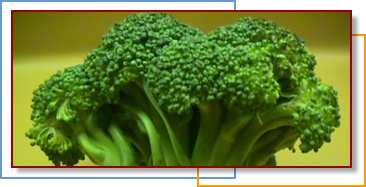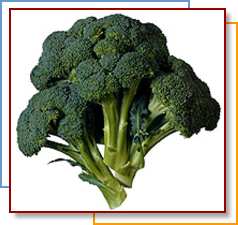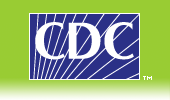
Broccoli has been around for more than 2000 years, The name "broccoli"
comes for the Latin word brachium, which means "branch," or "arm."
Americans have grown it in their gardens for only about 200 years! The
first commercially grown broccoli was grown and harvested in New York,
then planted in the 1920's in California. A few crates were sent back East
and by 1925 the broccoli market was off the ground.
Broccoli was first grown in the Italian province of Calabria and was
given the name Calabrese. Today there are many varieties. In the United
States, the most common type of broccoli is the Italian green or sprouting
variety. Its green stalks are topped with umbrella-shaped clusters of
purplish green florets.
Choose bunches that are dark green. Good color indicates high nutrient
value. Florets that are dark green, purplish, or bluish green contain more
beta-carotene and vitamin C than paler or yellowing ones. Choose bunches
with stalks that are very firm. Stalks that bend or seem rubbery are of
poor quality. Avoid broccoli with open, flowering, discolored, or
water-soaked bud clusters and tough, woody stems.
Store broccoli unwashed, in an open plastic bag and place in the
crisper drawer of refrigerator. It is best if used within a day or two
after purchasing.
Packaged frozen broccoli differs from fresh in its nutrient content.
The flower buds or florets are richer in beta-carotene than the stalks.
Manufactures typically cut off most of the stalk before packaging it, so
frozen broccoli may contain 35% more beta-carotene by weight than fresh
broccoli. The downside is that frozen broccoli has twice as much sodium as
fresh (up to 68 mg per 10 oz. package), about half the calcium, and
smaller amounts of iron, thiamin, riboflavin, and vitamin C.
The best way to cook broccoli is to steam, cook in the microwave or
stir-fry with a little broth or water. These methods are better than
boiling. Some of the vitamin and mineral content are lost from the
vegetable and end up in the cooking water when they are boiled. Cooked
broccoli should be tender enough so that it can be pierced with a sharp
knife, and still remain crisp and bright green in color.
|
|
Cooked
Broccoli |
Serving size
1/2 cup cooked (78g)
|
Amounts
Per Serving |
% Daily
Value |
| Calories
25 |
|
| Calories
from Fat 5 |
|
| Total Fat
0g |
0% |
| Cholesterol
0mg |
0% |
| Sodium 30mg |
1% |
| Total
Carbohydrate 6g |
2% |
|
Dietary Fiber 3g |
11% |
|
Sugars 1g |
|
| Protein 2g |
|
| Vitamin A |
30% |
| Vitamin C |
80% |
| Calcium |
4% |
| Iron |
2% |
* Percent Daily Values are based on a
2,000 calorie diet.
|
|
| |
|
|
|
|
Raw
Broccoli |
Serving size
1/2 cup raw (36g)
|
Amounts
Per Serving |
% Daily
Value |
| Calories
10 |
|
| Calories
from Fat 0 |
|
| Total Fat
0g |
0% |
| Cholesterol
0mg |
0% |
| Sodium 10mg |
0% |
| Total
Carbohydrate 2g |
1% |
|
Dietary Fiber 1g |
4% |
|
Sugars 1g |
|
| Protein 1g |
|
| Vitamin A |
20% |
| Vitamin C |
60% |
| Calcium |
2% |
| Iron |
2% |
* Percent Daily Values are based on a
2,000 calorie diet.
|
|
| |
|
|
 Recipes Recipes
Broccoli Soup
Makes 4 servings. (1 cup each)
Ingredients
1 1/2 cups chopped broccoli (or 10-ounce pkg. frozen broccoli)
1/4 cup diced celery
1/4 cup chopped onion
1 cup low sodium chicken broth
2 cups nonfat milk
2 Tbsp. cornstarch
1/4 tsp. salt
Dash pepper
Dash ground thyme
1/4 cup grated Swiss cheese
Place vegetables and broth in saucepan. Bring to boil, reduce heat,
cover, and cook until vegetables are tender (about 8 minutes). Mix milk,
cornstarch, salt, pepper, and thyme; add to cooked vegetables. Cook,
stirring constantly, until soup is lightly thickened and mixture just
begins to boil. Remove from heat. Add cheese and stir until melted. This
is an official Fruits & Veggies—More Matters recipe.
Nutritional Analysis Per Serving: calories 115, cholesterol 10mg,
sodium 255mg, fat 3g, calories from fat 24%.
Find more in our
recipe database!
|



